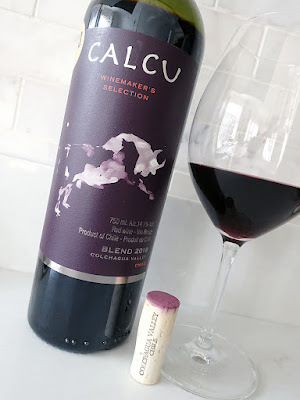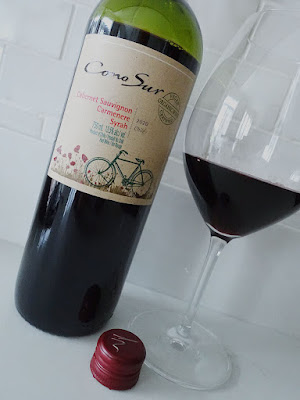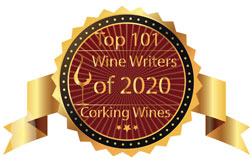red wine review is a lovely, unoaked blend of Syrah and Grenache from the Languedoc wine region in southern France that arrived at the LCBO as part of the recent LCBO VINTAGES New Release Collection on .
It is produced by Arnaud Sié at Château Tréviac, a family-owned estate that was established in the early 20th century by Arnaud's grandfather, Fernand, and is located in the heart of the Corbières Massif, halfway between the cities of Carcassonne and Narbonne, in the Occitan region in the South of France.
The story of Château Tréviac begins when Fernand settled in the village of Talairan after World War I, as he was convinced that the wild and untapped terroir of the region was full of great potential. He built a house on an old priory and cleared the hillsides in order to build the vineyard that exists to this day. The next generation, Lucette and her husband Roger, owned a labour-horse and, against all odds, managed to remain independent and out of the co-operative system. The journey continued with their daughter, Ginette, and her husband, André Sié. Each generation of this family of winemakers brought great passion as they built the walls and cellars of the Château, stone by stone. Today, with the same passion and dedication as his ancestors, Arnaud Sié manages Château Tréviac and crafts his wines. The name Tréviac came to be over time and refers to the three old roads: the Trois Voies junction (or TRI-VIA) where traces of former construction and burial sites remain today.
The rugged and stony terroir in Corbières is not only shaped by the hot Mediterranean sun, but also by the terroir of garrigue and scrub that affords its wines such bold characters. Château Treviac extends over 36 hectares of vines, which are primarily planted with Syrah and Grenache, on the rolling hillsides of the Corbières Massif, in one of the wildest parts of France with its picturesque countryside and rich biodiversity. The soils in the area are rich in limestone and clay, with calcareous rocks on the surface, while the micro-climate offers good sun exposure and a high-altitude, which allows the vines to enjoy hot temperatures during the day, and cooler temperatures at night. With a commitment to the preservation of biodiversity and terroir, Arnaud Sié made the decision in 2019 to begin the conversion process towards organic farming.
I've enjoyed previous vintages of this terrific unoaked red, including most recently the 2019 Château de Tréviac Corbières last October. It continues to be a blend of 60% Syrah and 40% Grenache that was hand-harvested. The grapes were crushed and pressed immediately upon arriving at the cellar and macerated for 4 to 5 weeks with regular punch downs to extract the aromas while respecting the integrity of the berries. In order to preserve freshness, the wine is raised in thermo-regulated concrete vats.
The 2020 growing season in Languedoc delivered excellent quality, albeit with slightly lower yields. It began with generous autumn rains, followed by a very mild December and a warm February, which helped get the vines off to an early start. The warm conditions continued into April and May, although rain arrived in unusually copious amounts in May, which led to downy mildew. However, the damage was limited. Cool and stormy weather arrived at the beginning of June, but thereafter, summer was hot and dry, without any heatwaves. Harvest arrived earlier than normal and growers were generally happy with the average-to-good crop size of juicy grapes, resulting in wines that are elegant, fresh, and aromatic. Let's see how this 2020 Corbières from Languedoc is tasting tonight...
This blend of 60/40 Syrah and Grenache was aged in concrete vats and has a medium-high intensity nose that offers a complex and attractive mix of ripe dark berry, blackberry, plum, garrigue, black raspberry, stony mineral, pepper spice, and meaty aromas. It's medium+ to medium-full bodied on the dry, ripe palate with lovely dark berry, blackberry, garrigue, stony mineral, and spice flavours which are supported by fresh acidity and fine-grained, grippy tannins. The dark berry notes taper to smoky minerals on the very long, crisp, and savoury finish. Highly recommended buy! Score: 90 pts
Other lovely wines by Arnaud Sié can be ordered through their Agent - Connexion Oenophilia / Noble Estates Wines & Spirits.
It is produced by Arnaud Sié at Château Tréviac, a family-owned estate that was established in the early 20th century by Arnaud's grandfather, Fernand, and is located in the heart of the Corbières Massif, halfway between the cities of Carcassonne and Narbonne, in the Occitan region in the South of France.
The story of Château Tréviac begins when Fernand settled in the village of Talairan after World War I, as he was convinced that the wild and untapped terroir of the region was full of great potential. He built a house on an old priory and cleared the hillsides in order to build the vineyard that exists to this day. The next generation, Lucette and her husband Roger, owned a labour-horse and, against all odds, managed to remain independent and out of the co-operative system. The journey continued with their daughter, Ginette, and her husband, André Sié. Each generation of this family of winemakers brought great passion as they built the walls and cellars of the Château, stone by stone. Today, with the same passion and dedication as his ancestors, Arnaud Sié manages Château Tréviac and crafts his wines. The name Tréviac came to be over time and refers to the three old roads: the Trois Voies junction (or TRI-VIA) where traces of former construction and burial sites remain today.
The rugged and stony terroir in Corbières is not only shaped by the hot Mediterranean sun, but also by the terroir of garrigue and scrub that affords its wines such bold characters. Château Treviac extends over 36 hectares of vines, which are primarily planted with Syrah and Grenache, on the rolling hillsides of the Corbières Massif, in one of the wildest parts of France with its picturesque countryside and rich biodiversity. The soils in the area are rich in limestone and clay, with calcareous rocks on the surface, while the micro-climate offers good sun exposure and a high-altitude, which allows the vines to enjoy hot temperatures during the day, and cooler temperatures at night. With a commitment to the preservation of biodiversity and terroir, Arnaud Sié made the decision in 2019 to begin the conversion process towards organic farming.
I've enjoyed previous vintages of this terrific unoaked red, including most recently the 2019 Château de Tréviac Corbières last October. It continues to be a blend of 60% Syrah and 40% Grenache that was hand-harvested. The grapes were crushed and pressed immediately upon arriving at the cellar and macerated for 4 to 5 weeks with regular punch downs to extract the aromas while respecting the integrity of the berries. In order to preserve freshness, the wine is raised in thermo-regulated concrete vats.
The 2020 growing season in Languedoc delivered excellent quality, albeit with slightly lower yields. It began with generous autumn rains, followed by a very mild December and a warm February, which helped get the vines off to an early start. The warm conditions continued into April and May, although rain arrived in unusually copious amounts in May, which led to downy mildew. However, the damage was limited. Cool and stormy weather arrived at the beginning of June, but thereafter, summer was hot and dry, without any heatwaves. Harvest arrived earlier than normal and growers were generally happy with the average-to-good crop size of juicy grapes, resulting in wines that are elegant, fresh, and aromatic. Let's see how this 2020 Corbières from Languedoc is tasting tonight...
Tasting Note:
CHÂTEAU DE TRÉVIAC CORBIÈRES 2020 - AP, Languedoc, France (#670505) (XD) - $17.95This blend of 60/40 Syrah and Grenache was aged in concrete vats and has a medium-high intensity nose that offers a complex and attractive mix of ripe dark berry, blackberry, plum, garrigue, black raspberry, stony mineral, pepper spice, and meaty aromas. It's medium+ to medium-full bodied on the dry, ripe palate with lovely dark berry, blackberry, garrigue, stony mineral, and spice flavours which are supported by fresh acidity and fine-grained, grippy tannins. The dark berry notes taper to smoky minerals on the very long, crisp, and savoury finish. Highly recommended buy! Score: 90 pts
Other lovely wines by Arnaud Sié can be ordered through their Agent - Connexion Oenophilia / Noble Estates Wines & Spirits.





































